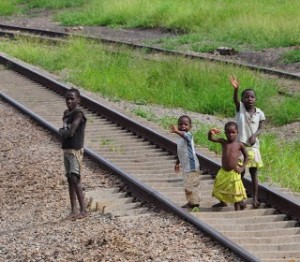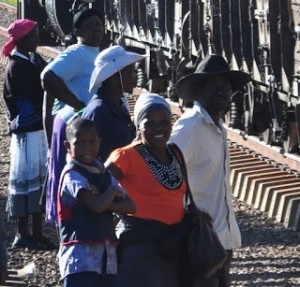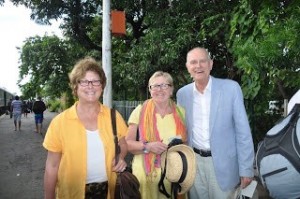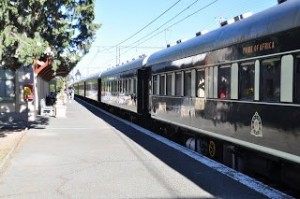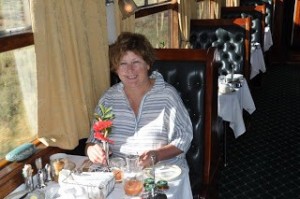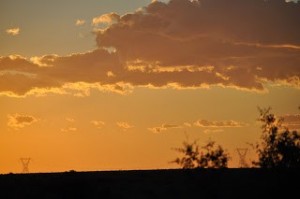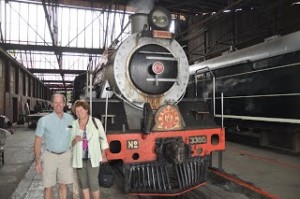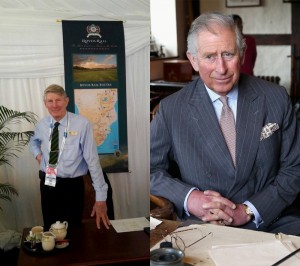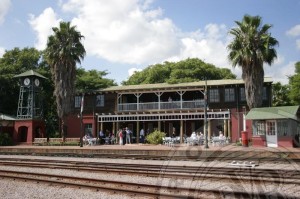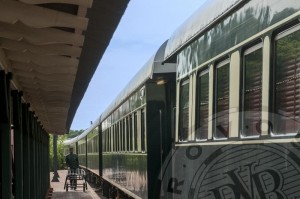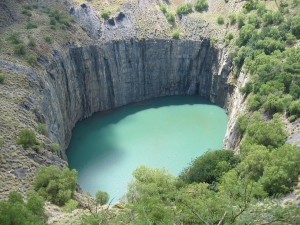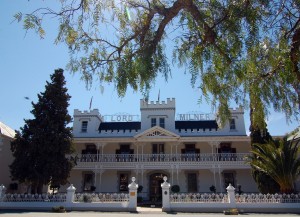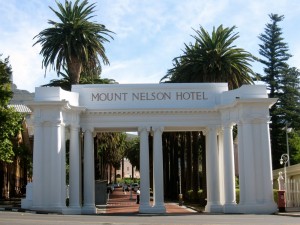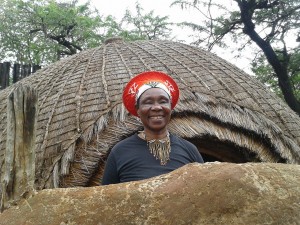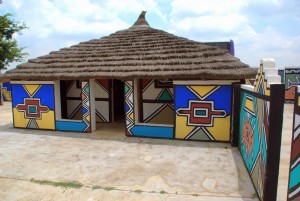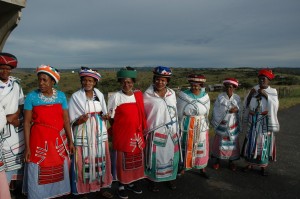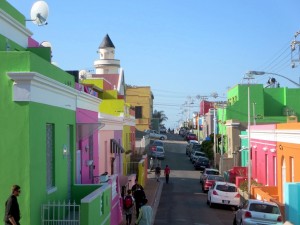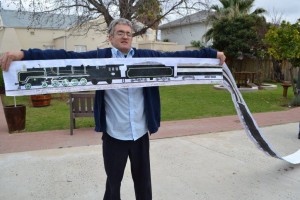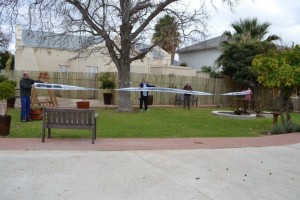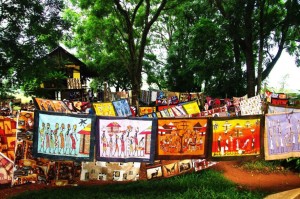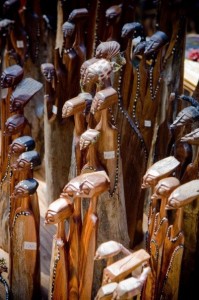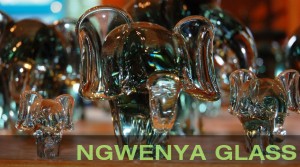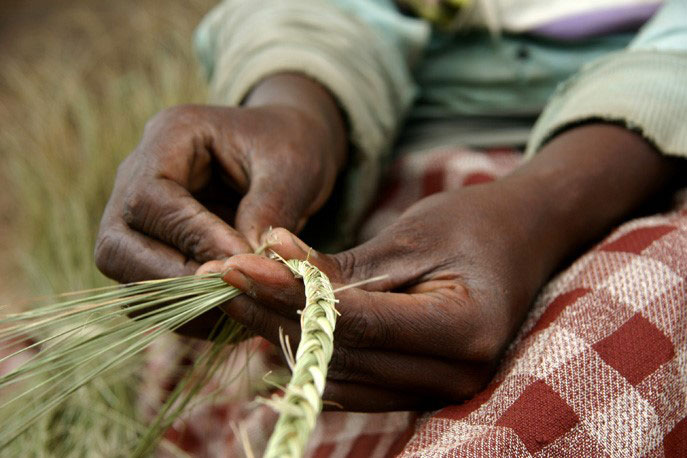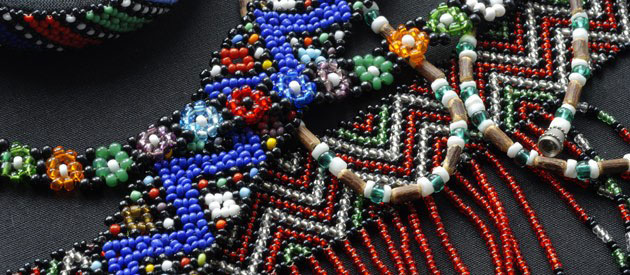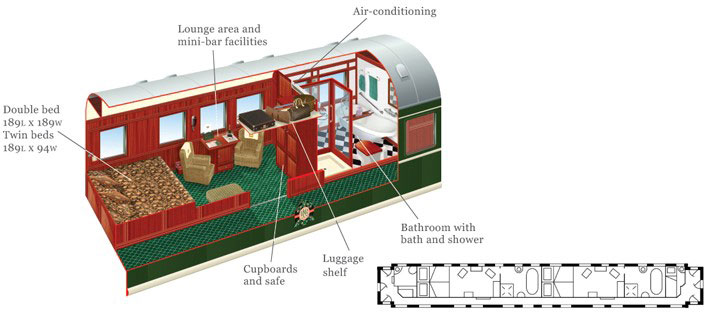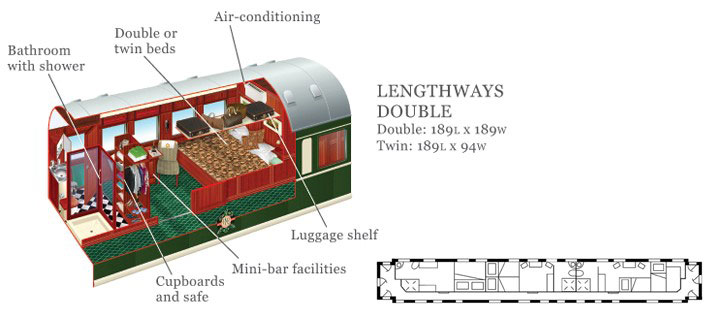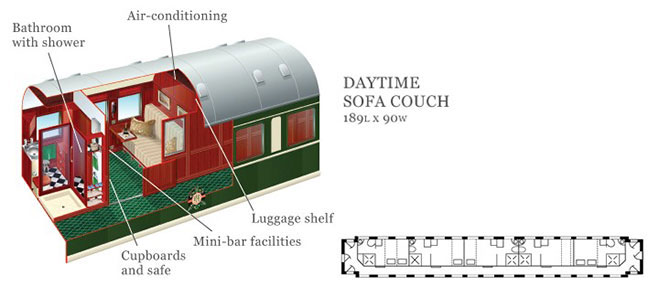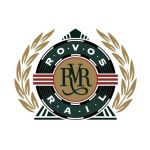We received this interesting description from John detailing his and his wife, Carolyn’s rail trip from Cape Town to Pretoria on the Rovos Rail. We enjoyed reading about their wonderful adventure so much that we simply had to share it with you.
Written by John
A mere month or so after our Chobe River and Victoria Falls adventure, we embarked on a rail trip from Cape Town to Pretoria on the Rovos Rail, the most luxurious train in the world. Ah, we can hear some of you already expressing doubt with comments like, “But I thought that the Orient Express was the most luxurious train in the world.” Au contraire, bru’s.
The Orient Express most emphatically was the most
luxurious of its era, and the modern incarnation
certainly has been authentically restored exactly as
it was in its hey-day. However, while cool no doubt,this historic preservation means that, although the
accommodations are deluxe, there are no showers
or baths on the Orient Express nor is there air conditioning.
On the Rovos Rail, you not only travel on meticulously restored Victorian/Edwardian carriages, but you also have suites with air conditioning and en-suite baths with showers, and even a few “Royal” suites with both a tub and shower. What’s more, the communal spaces are absolutely incredible. Piqued your curiosity? All aboard! It’s time to choo-choo with our soon-to-be chuffed chinas.
Lucky Reservations
Carolyn had read about the Rovos Rail around the time that we arrived in South Africa. Early in 2015, we looked into reserving on the Pretoria to Victoria Falls route, the most popular; however, not surprisingly, this trip was fully booked for 2015 and part way into 2016.
Rats!
But some good came of the inquiry: Carolyn got on the mailing list of a travel consultant at Rovos, and he emailed her some special low season rates for South African residents. Carolyn was able to book two guests for the price of one on the Cape Town to Pretoria route.
So, we were in business.
A Warm Reception at the Departure Lounge
Rovos Rail has its own private departure lounge across the street from the Cape Town Train Station. We arrived, and were immediately met by liveried Rovos staff who tagged our luggage with custom-made luggage tags printed with our names and berth number. They checked us in and offered us cold beverages including some South African bubbly. As you can see, the departure lounge has an air of understated luxury. A harp and strings were playing classical music. We sat down and almost immediately met a fascinating South African couple, Ian and Sandy – more about them later.
Cool Rovos Traditions and a Class Act
Rovos Rail has many cool traditions, not the least of which is that Rohan Vos personally sees off nearly every train. He was there for our departure, and gave everyone a brief orientation. His dry sense of humor was very entertaining. After asking if there were any Aussies or Kiwis on the train, several hands went up. Rohan shook his head and said, “That’s unfortunate because if your rugby teams continue to beat South Africa, I think that I will no longer allow you to ride on the train.”
After Rohan finished, we were called by name into small groups to be led by our host or hostess across the street to the train and our suites. As we walked out of the departure lounge, Rohan shook everyone’s hand and treated the repeat guests as if they were old friends.
What a class act!
All on Board!
The Deluxe Suite
Our assigned host led us to our deluxe suite. As you can see, it was very roomy and inviting (3 deluxe suites take up an entire carriage). As we settled in, the restaurant manager and chef arrived to discuss Carolyn’s request that her food contain no garlic as it strongly disagrees with her. After a short discussion, the Rovos team assured Carolyn that her culinary requirements would pose no problem.
Wow, what service!
Observation Car
After unpacking in our suite, we headed to the Observation Car at the rear of the train. Check out this one, chinas.
There was a bar and plenty of comfortable seating plus an outdoor area for those wishing to take the air. We took a couple of wingback chairs and ordered some pre-lunch bubbly. Did we mention that all food and drinks (spirits, beer, wine, soft drinks) are included in the price?
“They’re going to lose money on you,” laughed Carolyn.
“Not sure what you mean,” I replied. “I’m eating a lot less since my big 30 lb. weight loss.”
Carolyn merely shook her head and smiled. About this time, our new friends from the departure lounge, Ian and Sandy, arrived. I waved at them, and they joined us at the back of the car. We spent the hour and a half before lunch getting to know each other and enjoying these amazing views as the train made its way through the Cape Winelands past Stellenbosch, Paarl, and Franschhoek, into the Slanghoek Valley, and then eventually onto the Groot Karoo.
First Day – Delicious Lunch
At 1 PM, we went to the dining car. Ian and Sandy had gone before us and were at a table for four, and insisted that we join them.
Turns out that the trip was in celebration of Sandy’s birthday, so we were flattered that they would want to hang out with us, rather than having some alone time. Over the course of our conversation, we learned that Ian is a lifelong entrepreneur who has started various companies.
Lunch, by the way, was delicious. Following lunch, we made a quick stop to check out the beautiful Lounge Car.
First Stop – Matjiesfontein and the Lord Milner Hotel
After lunch, we spent some time enjoying the scenery from our suite. At about 4:30 PM, the train made its first stop in the small town of Matjiesfontein.
One of the reasons that the town is so well preserved is that when its founder, James Logan, passed away in 1920, the town was shut down and boarded up until 1968 when hotelier David Rawdon bought the town and restored it, even buying a red double-decker bus to give the town some additional character (as if it needed it). Rawdon died in 2010, and we have heard that his heirs cannot agree on what to do with the place, so once again it has been partially shut down and its future is uncertain.
Another interesting feature of the town is that there are said to be ghosts that haunt the Lord Milner Hotel and surrounding grounds. For us, the only near such paranormal encounter when we stayed at the Lord Milner was when we heard scratching at our room door after check-in only to find the hotel cat outside in the hallway looking for attention. After a brisk walk around the town, we returned to the train for sundowners in the Observation Car.
Bliss!
First Day – Delectable Dinner
Dinner on the Rovos requires minimum jacket and tie for men and the equivalent for women. We went to the dining car and secured a table for two, as we were sure that our new friends, Ian and Sandy, would want a romantic dinner alone in celebration of Sandy’s birthday.
Dinner was a lovely, long and leisurely affair featuring fantastic foods and inspiring wine pairings. Following dinner, we retired to our suite, where our host had laid out tea, coffee, and after-dinner drinks should we so desire. We finally went to bed, the movement of the train lulling us to sleep.
Now some folks, we understand, find it difficult to sleep on a moving train. Rovos has found a solution. From about midnight until 6:00 AM, the train was pulled off on a siding, so everyone could enjoy a motionless rest.
Ah, that Rohan, he thinks of everything.
Second Day
After a great sleep and rather exciting shower on a moving train, we headed to the dining car for breakfast. Ian and Sandy were there already and insisted we join them. After a delightful breakfast and more scintillating conversation, we headed to the on-board store where I bought a Rovos Rail golf shirt. We then spent time in the Lounge Car, after which we returned to our room to read and relax. Cell phone reception on the train is poor at best, and the use of phones is prohibited in the public spaces, so it is a relaxing, retro experience.
Before lunch at 1:30 PM, we went to the Observation Car where we again enjoyed pre-lunch libations with Ian and Sandy, then off to another exquisite lunch in the dining car.
Our next stop and excursion was coming up after lunch – Kimberley.
Kimberley – The Diamond Town
Kimberley is the capital of the Northern Cape Province. It is located approximately 110 km east of the confluence of the Vaal and Orange Rivers. The city has considerable historical significance due to its diamond mining past and the siege during The Second Boer War. Notable personalities such as Cecil Rhodes and Barney Barnato made their fortunes here, and the roots of the De Beers Company can be traced to the early days of the mining town.
Kimberley’s station is well preserved. All it needed was some people in period costumes to provide the illusion of a bygone era. We boarded a bus and set off through the town to see the Diamond Museum, described by Rovos Rail Journeys magazine as “an intensely interesting and a carefully constructed display of historical memorabilia housed next to the ‘Big Hole,’ which is the largest man-made [i.e., hand-dug] excavation worldwide.
Second Day – Dinner
We returned to the train station where the Rovos staff was waiting with “welcome back” bubbly. We retired once again to the Observation Car and saw an amazing flamboyance of flamingoes, as a flock is sometimes called. We enjoyed the scenery and Ian and Sandy joined us for pre-dinner cocktails. Afterwards went to our suites to change for dinner.
Rovos Rail Station
The next morning after breakfast, we arrived at the Rovos Rail private station at Capital Park, Pretoria. This once bustling hub of steam locomotion in the old Transvaal is now the headquarters for Rovos Rail. The site was derelict when Rohan Vos purchased it but has been transformed and includes a gracious colonial-style railway station, a repair, maintenance, and provisioning facility, and a railroad museum.
Prior to entering the rail yard, the diesel locomotives were detached from the head of the train and a steam locomotive was attached to the rear of the train to bring us into the station. The train engineer even let me climb up into the engineer’s cab to see the controls up close, something that I’ve always wanted to do since childhood when he watched the 1950’s TV show Casey Jones.
Our train trip over, we bid farewell to Ian and Sandy after exchanging contact details and promising to get together in Cape Town, (which we did just a few weeks ago at the Durbanville Hills Wine Festival). On to Pretoria!
Pretoria Perambulation
The Tour
Carolyn arranged with Rovos Rail to have a tour guide meet us at the Capital Park station. We decided that having a guide would allow us to cover the ground more quickly and see the most important sites. Our guide, Geert, was a most agreeable Afrikaner whose knowledge can only be described as encyclopedic. He also had a very good sense of humor.
The Union Buildings
From Wikipedia: “These form the official seat of the South African government and also house the offices of the president. The imposing buildings are located atop Meintjieskop. Though not in the centre of Pretoria the Union Buildings occupy the highest point of Pretoria, and constitute a South African national heritage site. They were designed by the architect Sir Herbert Baker in the English monumental style, and are 285 meters (935 feet) long. They have a semi-circular shape, with the two wings at the sides; this serves to represent the union of a formerly divided people. The clock chimes are identical to those of Big Ben in London. The east and west wings, as well as the twin-domed towers, represent two languages, English and Afrikaans, and the inner court symbolises the Union of South Africa. These buildings are considered by many to be the architect’s greatest achievement and a South African architectural masterpiece.”
The buildings are most impressive. President Nelson Mandela gave his inaugural speech in front of these buildings. There is now a 9 metre (30 feet) high statue of Mandela in front of the buildings. If you saw the movie Invictus, you may recognize the buildings.
Melrose House
Melrose House was built in 1886 by George Jesse Heys, a prominent business mogul in Pretoria at the time, who made his fortune running a fleet of post (stage) coaches, among other things.
Lord Roberts, commander of the British Forces during the Second Anglo-Boer war, requisitioned Melrose House in June 1900 as the headquarters of the British forces, after Pretoria was invaded. Later in the war, Lord Kitchener, Roberts’ replacement, used it as well. The Peace Treaty of Vereeniging, the crucial document that ended the war, was signed in 1902 in the dining room. When George Heys died a decade or so later, his family closed the house and decamped to England.
The city of Pretoria acquired the property in the 1960’s and turned it into a museum. Because the house was shuttered, nearly all of the original furniture and furnishings are still there, including a little girl’s porcelain tea set and toys.
The grand interior of Melrose House includes beautiful stained glass windows, plush carpets in opulent colours, paintings by British artists, exquisitely ornate fireplaces and ceilings, and an array of gorgeous porcelain ornaments. We have never seen such a superbly preserved house. We almost did not get into the house, as we arrived on a Monday when the museum is normally closed. However, our guide spoke to a sympathetic museum employee who allowed us inside for a private tour. We took a few photos after which we realised there were signs forbidding photography. Oh well.
Kruger House
Kruger House is the historical Pretoria residence of the Boer leader and President of the South African Republic, Paul Kruger. It was built in 1884 by architect Tom Claridge and builder Charles
Clark. Milk was used, instead of water, for mixing the cement from which the house was constructed, as the cement available was of poor quality. The house contains either the original furnishings or items from the same historical period, some of the many gifts that were presented to Kruger, as well as other memorabilia including the presidential private rail carriage. Unfortunately, photos are not allowed here either, so we only have photos of the exterior and Kruger’s church across the street.
Voortrekker Monument
The Voortrekker Monument stands over 40 meters tall (131 feet) on its hilltop home and is visible from a large part of Pretoria. It was built to commemorate the history of the Afrikaner pioneers who left the Cape Colony, where they had suffered under British rule, to travel to the interior of the country from 1835 to 1854 on what has come to be known as the Great Trek. Both within and around the monument, every aspect of the building has a historic or symbolic significance. The front gate is in the form of Zulu assegais (stabbing spears). The walls around the monument are in the form of a laager of the wagons used by the Voortrekkers. A unique marble Frieze circles the inside walls of the Monument. In bas-relief, 27 panels depict the story of the Great Trek from 1835 to 1852.
The Great Trek and the Zulus
The Frieze not only shows the history of the Great Trek but also shows how the Voortrekkers went about their everyday lives. Moreover, it provides an insight into the religious beliefs and work methods of the Voortrekkers, as well as important conflicts, such as the Zulu slaughter of Piet Retief and his party and the Battle of Blood River where 470 Voortrekkers led by Andries Pretorius (the city of Pretoria is named after him) defeated an estimated 15,000-20,000 Zulus, inflicting over 3000 casualties.
Interestingly, in our 2-1/2 years in South Africa, we have heard about Blood River from several points of view. The Zulus believe that they lost due to “bad medicine,” i.e., their gods turning against them. The Voortrekkers, on the other hand, recorded that they had the advantage of a very defensible position that made a perfect killing ground plus a dense fog that concealed them from the Zulus until it was too late. As the Voortrekkers were deeply religious and believed that God would manifest himself through nature (in this case, the fortuitous fog), they believed that God had shown his favor and that they were his chosen people.
Many English, on the other hand, seem absolutely certain that the Voortrekkers exaggerated both the total number of Zulus present as well as the number killed.
A Commemoration
Cenotaph Hall is located on the lower floor and houses the Cenotaph (empty tomb) and an amazing tapestry depicting The Great Trek. Every year on December 16, the date of the Battle of Blood River, the sun shines down through a small hole in the center of the Voortrekker Monument roof onto the Cenotaph, lighting up the inscribed words: “Ons vir jou, Suid Africa” (“We for thee, South Africa”)
Return to Cape Town
With that, we went off to spend the night in Sandton, a suburb of Johannesburg, and then back to Cape Town the next day.
So there you have it, china’s. We hope that you enjoyed our double feature. Do come to Africa – we’re always ready to rant and “rail” with all of our lekker bru’s.
See you next time,
John and Carolyn
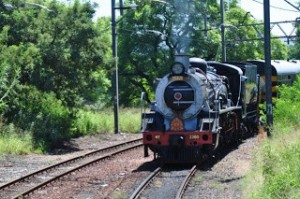 lling counterparts searching out the steam engines and reliving a boy’s lost memories.
lling counterparts searching out the steam engines and reliving a boy’s lost memories.
